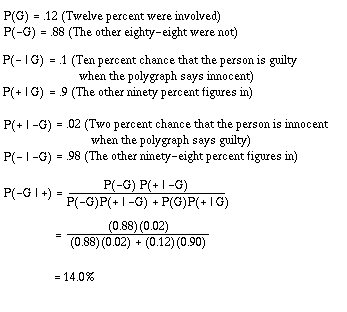Selected Answers to Problem Set 2
3. You can try my script here or read the source code for the Perl script here. This, of course, is one method that can achieve the ultimate goal. Hopefully I made the source very easy to read, follow and understand.
4. The odds that two people out of 100 share the same code is 39.1%. This
problem is very similar to the problem #3 on Problem Set 1 except that this
time there is no replacement; once a code is used it cannot be used again.
The problem can be treated in a similar fashion.
Compute the odds that no one out of 100 people share the same code:
Person 0 has (10000/10000) numbers to 'choose' from.
Person 1 has (9999/10000) numbers to choose from
...
Person N has ((10000-N) / 10000) numbers to choose from
Odds of no two alike: Pf = (9999/10000)(9998/10000)...(9901/10000)
Odds of two alike: Pt = 1 - Pf = 1 - (9999/10000)...(9901/10000) = 39.1%
The second problem, with 150 people, is solved in the same way. This time, multiply until (9851/10000) to achieve 67.5%.
5. With both students guessing a tire, there is a 25% chance they will guess the same tire. It doesn't really matter what tire the first student says. The second student has a 1/4 chance of guessing what the first student said.
6. If 1/3 of the class is female and half the females smoke, then 1/6 of
the class are female smokers. Likewise, if 2/3 of the class is male and 1/3
of the males smoke, then 2/9 of the class are male smokers. To find the
percentage of females smokers from all smokers:
(F | S) / (F | S + M | S) = (1/6) / (1/6 + 2/9) = 3/7
3/7, or 42.9% of the smokers are female.
7. We want to find P(-G | +), where -G is not guilty (innocent) and + is
the result of the polygraph test.
